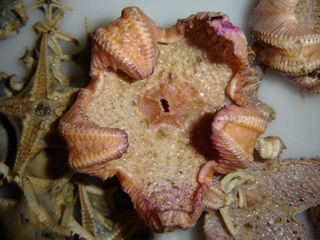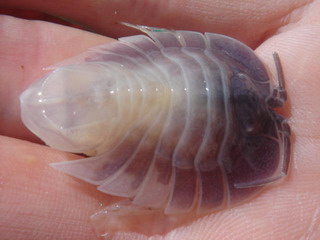After 12 hours at over 4000 m below the surface, the trawl
finally arrived on deck yesterday morning with many eager
scientists awaiting what creatures of the deep sea the net
might hold. The cod end of the net was carefully opened
and out spilled enough deep-sea creatures to fill the two
large containers we had on deck! It was a tremendous catch,
despite a large rip in the trawl net and there was much
excitement onboard. 
The trawl coming onboard!
Very little is known about the deep-sea fauna around the
Crozet Islands, and trawls like this provide scientists
with pioneering knowledge of the diversity and abundance
of large animals (megafauna) living on the seabed. Few people
have studied the deep sea around the Islands, and it is
likely that some of the species discovered yesterday will
be new to science

Opening the cod end of the trawl
net and filling the buckets |

Tania, Dave Billet and the team
get suck in! |

Trawl net contents
As well as many different deep-sea fishes, the trawl contained
a remarkable diversity of invertebrates with many Phyla
represented. There were sponges, giant anemones, worms,
sea spiders, bright red shrimps, snails, clams, sea stars,
brittle stars, sea cucumbers, sea urchins and a coral. Some
other “enigmatic forms” were also discovered
and these will be taken back to the UK for further identification.
The animals found in the trawl all have special adaptations
to life in the deep sea, and often look very different to
animals from shallow water.
It was a very successful trawl both in terms of the quantity
and diversity of animals collected. Numerically, hundreds
of sea cucumbers and brittle stars dominated the catch.
Sea cucumbers dominated the fauna in terms of biomass and
probably diversity, as many different species were found.
It is likely that these animals are particularly well suited
to life in the deep sea here at M5.
|
|
|
Click on the
pictures for a larger version. Opens in new window/tab |
Sorting out all the different animals from each trawl can
take a long time, especially if it’s a good one! Luckily
it was a nice sunny Southern Ocean day yesterday and we
had plenty of volunteers out on deck willing to get their
hands slimy picking out the sea stars from the brittle stars
and the sea cucumbers from the jellyfish.

Sorting the animals
Once all the animals were sorted into different groups
they were weighed and carefully preserved in jars to take
back to the “Discovery” Collections at the National
Oceanography Centre, Southampton (NOCS). These collections
date back over a hundred years and contain samples from
the first ship “Discovery” on which Scott and
Shackleton sailed. Some samples have also been frozen aboard
our “Discovery” for biochemical analysis. Once
back at NOCS the specimens will be analysed further and
compared to samples from the other site, M6, which we will
be going to next. The trawl we used is called an OTSB 14
and it is hoped that 4 trawls in total will be taken from
each of the two main stations, M5
and M6.
 A sea star from the deep
A sea star from the deep |
 Deep sea isopod
Deep sea isopod |
|
Click on the
pictures for a larger version. Opens in new window/tab |